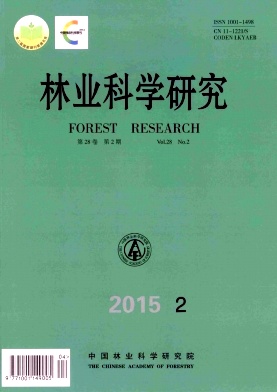|
[1]
|
李德志, 臧润国. 森林冠层结构与功能及其时空变化研究进展[J]. 世界林业研究, 2004, 17(3): 12-16.
|
|
[2]
|
邱建丽, 李意德, 陈德祥, 等. 森林冠层结构的生态学研究现状与展望[J]. 广东林业科技, 2008, 24(1): 75-82.
|
|
[3]
|
Wang Y P, Jarvis P G. Influence of crown structural properties on PAR absorption, photosynthesis, and transpiration in Sitka spruce: application of a model (MAESTRO)[J]. Tree physiology, 1990, 7(1): 297-316. |
|
[4]
|
Stockle C O. Canopy photosynthesis and transpiration estimates using radiation interception models with different levels of detail[J]. Ecological modelling, 1992, 60(1): 31-44. |
|
[5]
|
Campbell G S. Extinction coefficients for radiation in plant canopies calculated using an ellipsoidal inclination angle distribution[J]. Agricultural and forest meteorology, 1986, 36(4): 317-321. |
|
[6]
|
Normand F, Bissery C, Damour G, et al. Hydraulic and mechanical stem properties affect leaf–stem allometry in mango cultivars[J]. New Phytologist, 2008, 178(3): 590-602. |
|
[7]
|
Almeras T, Costes E, SALLES J C. Identification of biomechanical factors involved in stem shape variability between apricot tree varieties[J]. Annals of Botany, 2004, 93(4): 455-468. |
|
[8]
|
McConnaughay K D M, Coleman J S. Biomass allocation in plants: ontogeny or optimality? A test along three resource gradients[J]. Ecology, 1999, 80(8): 2581-2593. |
|
[9]
|
Weiner J. Allocation, plasticity and allometry in plants[J]. Perspectives in Plant Ecology, Evolution and Systematics, 2004, 6(4): 207-215. |
|
[10]
|
Westoby M, Falster D S, Moles A T, et al. Plant ecological strategies: some leading dimensions of variation between species[J]. Annual review of ecology and systematics, 2002, 33(1): 125-159. |
|
[11]
|
Enquist B J, Niklas K J. Invariant scaling relations across tree-dominated communities[J]. Nature, 2001, 410(6829): 655-660. |
|
[12]
|
Enquist B J, Niklas K J. Global allocation rules for patterns of biomass partitioning in seed plants[J]. Science, 2002, 295(5559): 1517-1520. |
|
[13]
|
易同培, 史军义, 马丽莎, 等. 中国竹类图志[M]. 北京: 科学出版社, 2008.
|
|
[14]
|
谢碧霞, 陆志科. 麻竹叶抑菌活性成分的分离鉴定[J]. 中南林学院学报, 2005, 25(5): 10-14.
|
|
[15]
|
周本智, 吴良如, 邹跃国. 闽南麻竹人工林地稍部分现存生物量的研究[J]. 林业科学研究, 1999, 12(1): 47-52.
|
|
[16]
|
邓玉林, 陈其兵, 江 心. 引栽麻竹特性及优化培肥方案初探[J]. 四川农业大学学报, 2000, 18(1): 43-45.
|
|
[17]
|
邱尔发, 陈卓梅, 郑郁善, 等. 山地麻竹笋用林生态系统生物量、生产力及能量结构[J]. 林业科学研究, 2004, 17(6): 726-730.
|
|
[18]
|
邱尔发, 陈卓梅, 郑郁善, 等. 麻竹山地笋用林凋落物发生、分解及养分归还动态[J]. 应用生态学报, 2005, 16(5): 811-814.
|
|
[19]
|
邱尔发, 洪 伟, 郑郁善, 等. 麻竹山地笋用林笋期叶片光合及呼吸性状研究[J]. 林业科学, 2001, 37(S1): 148-153.
|
|
[20]
|
Fabbro T, Körner C. Altitudinal differences in flower traits and reproductive allocation[J]. Functional Ecology of Plants, 2004, 199(1): 70-81. |
|
[21]
|
顾大形, 陈双林, 郭子武, 等. 四季竹立竹地上现存生物量分配及其与构件因子关系[J]. 林业科学研究, 2011, 24(4): 495-499.
|
|
[22]
|
郭子武, 杨清平, 李迎春, 等. 密度对四季竹地上生物量分配格局及异速增长模式的制约性调节[J]. 生态学杂志, 2013, 32(3): 515-521.
|
|
[23]
|
庄明浩, 李迎春, 陈双林. 竹子生理整合作用的生态学意义及研究进展[J]. 竹子研究汇刊, 2011, 30(2): 5-9.
|
|
[24]
|
Stevens M T, Kruger E L, Lindroth R L. Variation in tolerance to herbivory is mediated by differences in biomass allocation in aspen[J]. Functional Ecology, 2008, 22(1): 40-47. |
|
[25]
|
朱强根, 金爱武, 王意锟, 等. 不同营林模式下毛竹枝叶的生物量分配: 异速生长分析[J]. 植物生态学报, 2013, 37(9): 811-819.
|
|
[26]
|
Eyles A, Pinkard E A, Mohammed C. Shifts in biomass and resource allocation patterns following defoliation in Eucalyptus globulus growing with varying water and nutrient supplies[J]. Tree physiology, 2009, 29(6): 753-764. |
|
[27]
|
Alcorn P J, Forrester D I, Thomas D S, et al. Changes in whole-tree water use following live-crown pruning in young plantation-grown Eucalyptus pilularis and Eucalyptus cloeziana[J]. Forests, 2013, 4(1): 106-121. |
|
[28]
|
Quentin A G, Pinkard E A, Beadle C L, et al. Do artificial and natural defoliation have similar effects on physiology of Eucalyptus globulus Labill. seedlings?[J]. Annals of Forest Science, 2010, 67(2): 203. |
|
[29]
|
孙尚伟, 尹伟伦, 夏新莉, 等. 修枝对复合农林系统内小气候及作物生长的影响[J]. 北京林业大学学报, 2009,31(1): 25-30.
|
|
[30]
|
李 钰, 赵成章, 董小刚, 等. 高寒草地狼毒枝-叶性状的坡度差异性[J]. 植物生态学报, 2013, 37(8): 709-717.
|
|
[31]
|
Brouat C, McKey D. Leaf-stem allometry, hollow stems, and the evolution of caulinary domatia in myrmecophytes[J]. New Phytologist, 2001, 151(2): 391-406. |
|
[32]
|
Westoby M, Wright I J. The leaf size-twig size spectrum and its relationship to other important spectra of variation among species[J]. Oecologia, 2003, 135(4): 621-628. |
|
[33]
|
Corner E J H. The durian theory or the origin of the modern tree[J]. Annals of Botany, 1949, 13(4): 367-414. |
|
[34]
|
Gillespie A R, Allen H L, Vose J M. Amount and vertical distribution of foliage of young loblolly pine trees as affected by canopy position and silvicultural treatment[J]. Canadian Journal of Forest Research, 1994, 24(7): 1337-1344. |





 DownLoad:
DownLoad: